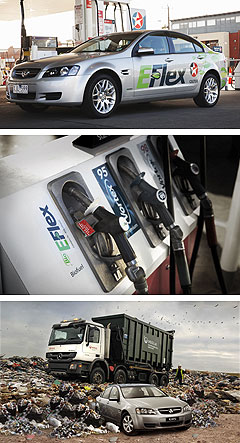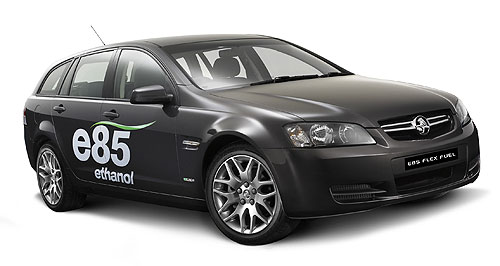Make / Model Search
News - General News - RegulationAustralian government gets serious on E85Getting serious: The federal government wants to implement a set of standards for bio-ethanol fuel, which powers vehicles such as the flex-fuel Holden Commodore Sportwagon. Canberra proposes quality and retail standards for ethanol-based E85 bio-fuel20 Jun 2011 THE Australian government is proposing a set of standards for bio-ethanol-based E85 fuel, including fuel quality and properties, service station storage and safety procedures, and labelling on bowsers to prevent customers misfuelling incompatible vehicles. The proposed standards, published on Friday by the Department of Sustainability, Environment, Water, Population and Communities (DSEWPC), are based on existing EU and US legislation, tailored to suit Australian market and climate conditions. The Australian take on existing standards was devised following consultation with ethanol producers, vehicle manufacturers and the Fuel Standards Consultative Committee (FSCC). The DSEWPC said most stakeholders – which include the states and territories, the Commonwealth, fuel producers, vehicle manufacturers, environmental groups and consumers – agree that there is a need for an E85 fuel standard and have been invited to submit feedback by July 29. GM Holden director of external communications Emily Perry told GoAuto that Holden has been “working closely with the government and other stakeholders on this project for some time”.  Left: Caltex E-Flex station and bowser. Below: Coskata create bio-fuel from rubbish otherwise condemned to landfill (digital image). Left: Caltex E-Flex station and bowser. Below: Coskata create bio-fuel from rubbish otherwise condemned to landfill (digital image).“We welcome a national fuel standard for ethanol and we will make a submission and discuss our recommendations at that point.” The standards will define the acceptable quality and chemical properties the E85 fuel, including the variations in ethanol content that can affect engine starting in cold conditions. For example, Europe has five classes of E85 that vary the ethanol content from 50 per cent upwards depending on climate and season (colder temperatures require a lower ethanol content to produce enough vapour for effective combustion). The US similarly has three classes, with the lowest ethanol content being 68 per cent. The Australian government proposes two blends, winter and summer, the lowest ethanol content being 70 per cent. For the US and proposed Australian fuel blends, the amount of petrol in the mix is determined by the ethanol volume and vapour pressure within a given temperature range. The government proposes two options for the distribution of the winter and summer fuel blends. One is for the industry to self-regulate and distribute the fuel as it sees fit, the other for the government to prescribe zones in which the relevant fuel is distributed according to season. The second option reflects the method used in Europe and the US. Under this scheme, tropical parts of Western Australia, Queensland and the Northern Territory would use the summer blend all year round, Tasmania would always use the winter blend and the rest of Australia would vary the blend according to season. The DSEWPC is also proposing an information standard to deal with a lack of customer awareness that could lead to misfuelling. The paper recommends warning labels on service station pumps and cites Caltex as an example for the clear labelling of its E85 product through its E-Flex branding. According to the paper Caltex also trains service station staff and is “implementing pump authorisation, vehicle identification and nozzle latch mechanisms to minimise the risk of misfuelling”. Due to ethanol’s tendency to attract water, the proposed standard also requires “additional housekeeping and monitoring” at storage and dispensing sites, again citing Caltex – which also provides advice for fire-fighting and emergency procedures for sites selling E85 – as an example to follow. In Australia, ethanol for road fuel use is largely made from feedstocks such as wheat grain, sorghum or by-products of the sugar cane industry, but production of bio-ethanol using land and crops that could otherwise enter the food chain is potentially controversial. Some ethanol is already produced from waste products of the flour industry and, as GoAuto has reported, Holden, Caltex and US bio-fuel firm Coskata have entered into a consortium to create ethanol from rubbish that would otherwise go to landfill. The move to embrace E85 in Australia comes at a time when the fuel is starting to lose favour in the US – and with Holden’s parent company, General Motors. GM chairman and CEO Dan Akerson told The Detroit News he believes ethanol is “going to die slowly”. In a move away from ethanol, Mr Akerson also said that next year GM will unveil a new bi-fuel commercial vehicle engine capable of running on compressed natural gas (CNG) or petrol. The US Senate also recently voted overwhelmingly in favour of abolishing subsidies for corn-based ethanol producers, which have been widely criticised and blamed for increasing food prices – a view echoed by the World Bank. The US subsidies, backed up by tariffs on imported ethanol, had also been criticised as being anti-competitive by ethanol-producing countries like Brazil – where ethanol has been a compulsory ingredient in petrol since the 1970s and E100 (pure ethanol) fuel is widely used. The ethanol industry in Europe has also taken a hit, with the UK’s largest wheat-derived ethanol plant reportedly closing temporarily in response to high wheat prices. European brands including Opel and Audi have also indicated a move towards CNG as an alternative fuel, the latter investing heavily in wind and solar energy to power technology that will create the gas synthetically by extracting hydrogen from water and combining it with CO2 to create methane. In addition, the Euro 5/6 emissions standards could cause E85-powered cars to fall foul of the cold-start emissions test, which is done at minus-seven degrees Celsius. The potentially deal-breaking Euro5/6 cold-start test is conducted at a temperature rarely experienced in most of Australia, so Holden is appealing for the government to agree to a waiver for E85-powered cars. Ms Perry said Holden is “working with the government to ensure the cold-start testing regime is suitable for ethanol-based fuel in Australia” and that ethanol remains part of the brand’s alternative fuel strategy. “Ultimately, markets around the world with different regulatory approaches, needs and resources will focus on different solutions when it comes to alternative fuels and technologies – but for Holden and Australia ethanol still represents a great alternative,” she said. “Holden likes to use the phrase ‘there’s no silver bullet, more like silver buckshot’ – that is, there will be a range of different solutions when it comes to sustainability. “The great thing about our approach is that we have invested in a range of solutions which we think are suitable for this market – and our export markets – like ethanol and LPG.” Before August 2010, when Caltex began its rollout of 100 initial outlets for ‘Bio E-Flex’ E85 fuel to coincide with the arrival of Holden’s flex-fuel VE Series II Commodore, only a few independent suppliers dotted around the country sold the fuel. Until the VE Series II hit the streets, only a few Saabs, Bentleys and race cars were compatible, but ethanol is not new to Australia and fuel containing up to 10 per cent ethanol has been available here for more than a decade. The New South Wales government plans to make E10 – with which most cars produced since 1986 are compatible – a mandatory replacement for standard unleaded from July 2012. Holden estimates that, even with just 100 Caltex outlets located in capital cities (except Perth and Darwin), 90 per cent of Australian ‘flex-fuel’ Series II Commodores buyers will reside within 10km of an E85 outlet, and by 2030 the fuel will help reduce petrol usage in Australia by 30 per cent. It also claims that E85 – which retails about 20 cents per litre cheaper than regular unleaded – is subject to less price volatility than petrol, which is subject to the ever-changing cost of internationally traded crude oil. Ms Perry said E85 “represents a huge opportunity for Australia to produce the fuel locally and reduce well-to-wheel driving emissions by around 40 per cent.”  Read more14th of June 2011  Holden seeks US rules for flex-fuel testCanberra to talk on emissions test rules that threaten to leave E85 out in the cold14th of June 2011  Ford buys time on engine deadlinePhased Euro 5 emissions introduction points to 2016 crunch date for Ford I618th of January 2011  Victoria leads global ethanol templateVictorian facility to lead global Coskata ethanol municipal waste plant model14th of September 2010  Ethanol to ‘future-proof’ Holden CommodoreE85, iQ and Redline to maintain Commodore’s relevance in Australia, says Holden1st of September 2010  Holden charts new waters with ethanolE85 Commodore set to broaden Holden brand audience, despite consumption drawbacks3rd of August 2010  Commodore to go it alone on E85 for nowHolden set to wait on ethanol-capable Cruze when production goes local |
Click to shareGeneral News articlesResearch General News Motor industry news |











Facebook Twitter Instagram